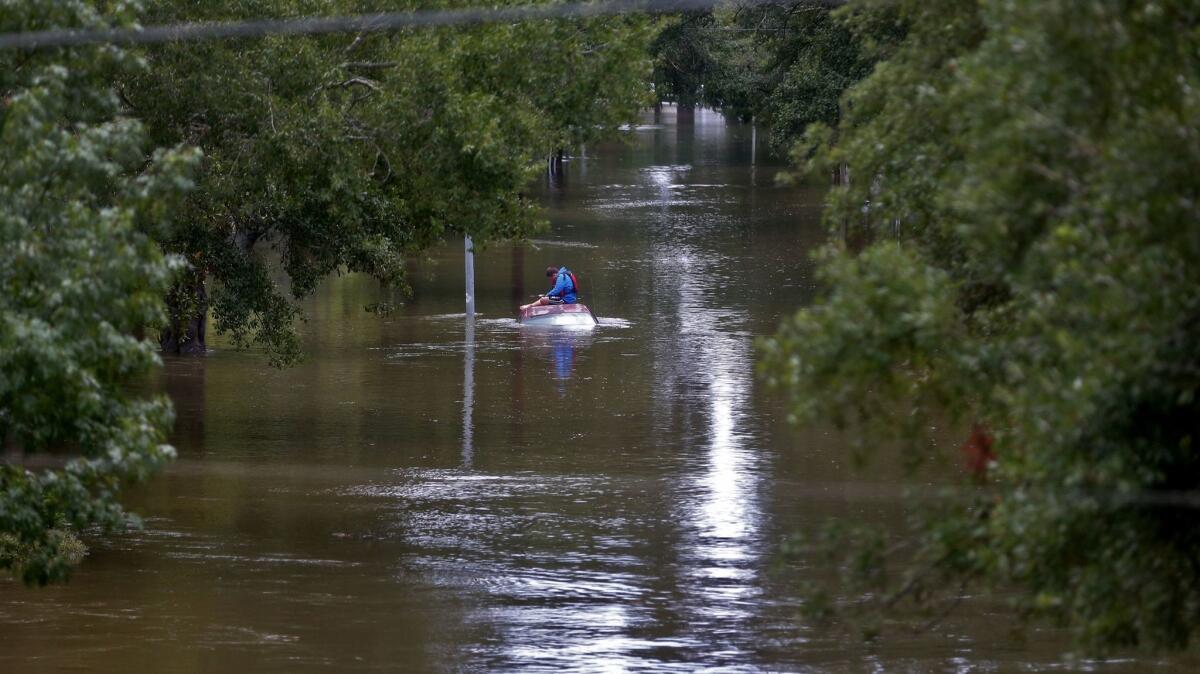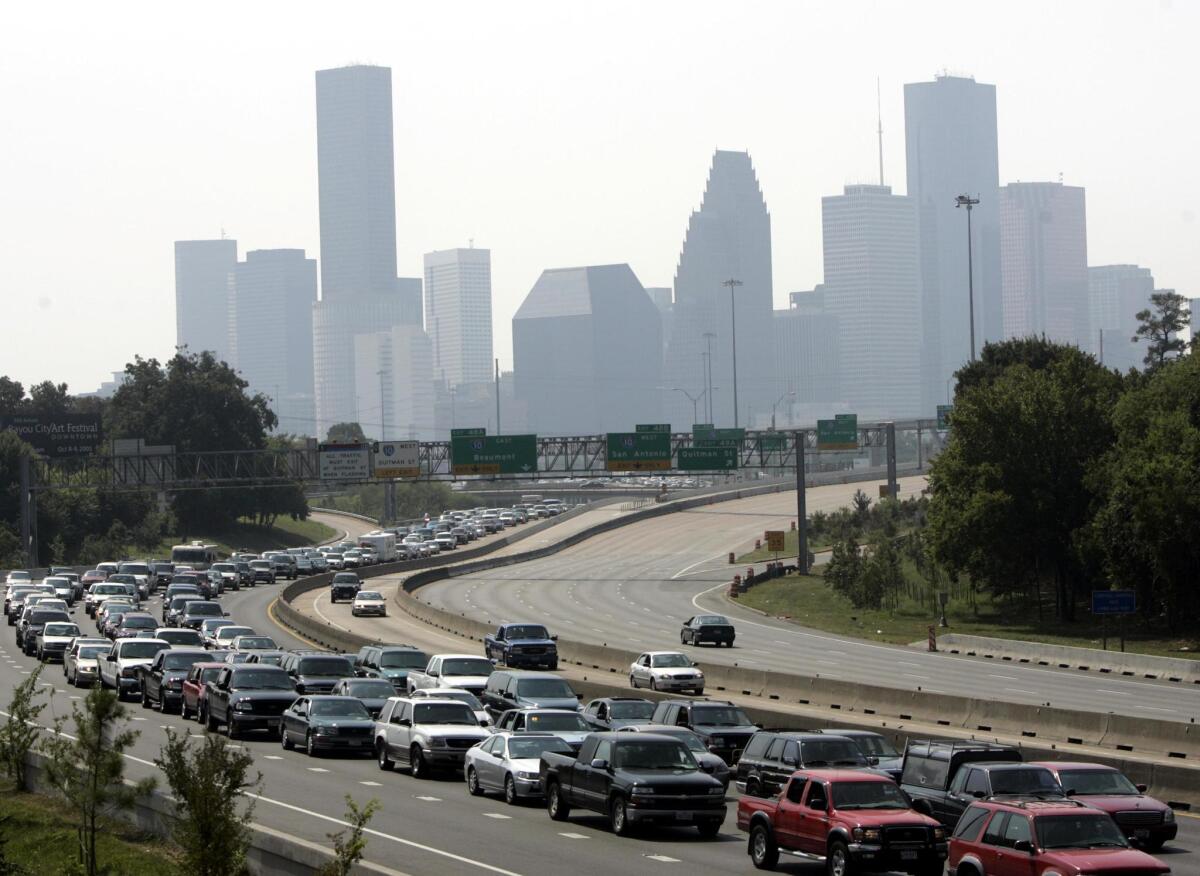Why didn’t Houston evacuate before Harvey? It’s not that simple

- Share via
As Tropical Storm Harvey barreled toward the Gulf Coast, Texas Gov. Greg Abbott urged residents of coastal and low-lying areas to evacuate and head to higher ground.
No one could know how bad the flooding would be, he said, and it wasn’t worth taking the risk.
“Even if an evacuation order hasn’t been issued by your local official… you need to strongly consider evacuating," Abbott said Friday. “You don’t want to put yourself in a situation where you could be subject to a search and rescue.”
Abbott’s evacuation plea was in direct contradiction with local officials, who for days had been urging Houston to remain calm and stay off the roads. Some invoked the deadly traffic jams of Hurricane Rita in 2005 to remind residents that fleeing could be more fatal than staying in their homes.
As floodwaters rose, leaving residents trapped on upper floors or waving sheets from rooftops, Houston officials have been repeatedly forced to defend their decision, as critics questioned whether it was the right one.
“You literally cannot put 6.5 million [people] on the road,” Mayor Sylvester Turner said Sunday when asked again whether the city should have evacuated. “If you think the situation right now is bad — you give an order to evacuate, you are creating a nightmare.”
Asked again Monday about the decision, Turner added: “You put millions of people on the road and they are running into a storm. … The best place for Houstonians and the people of Harris County was right here.”
The shadow of Hurricane Rita
‘Don’t follow the example of New Orleans’

In 2005, less than a month after
As Hurricane Rita approached the Gulf Coast, buffeted by 175 mph winds, officials — in no uncertain terms — ordered more than 1.3 million residents to leave beach cities and low-lying areas of Houston and head for higher ground.
“The time for waiting is over,” then-Houston Mayor Bill White urged residents. “Don’t follow the example of New Orleans and think that someone’s going to get you.”
An estimated 3.7 million people attempted to flee the region, overwhelming Houston’s vast interstate network and creating miles-long traffic jams with no entry or exit points. ("It was like we were yelling 'fire,' but all the doors were shut," one Houston city councilwoman said afterward.)
Dozens suffered heat stroke on the highways. Fights broke out. Some evacuees gave up and went home; others ran out of gas and abandoned their cars. A Times reporter spent more than 14 hours driving 70 miles from Galveston to greater Houston, in an endless, crawling line of congestion.
More than 60 of the 100 deaths in Texas during the storm were later connected to the chaotic evacuation, according to a 2006 report to state lawmakers. Among other issues, the report noted, officials had not anticipated that images from Katrina, fresh in the regional psyche, would encourage more people to leave.
In the most deadly incident, a chartered bus carrying nursing home patients stalled on the side of Interstate 45 and caught fire, killing 23 people.
Why Houston didn’t evacuate this year
‘The alternative would have been a disaster.’
In the days leading up to Harvey, officials were acutely aware that the risk of death across the city could be much higher if officials botched an evacuation attempt, and saw a repeat of Hurricane Rita.
An evacuation would require funneling a significant number of the region’s 6 million residents onto three main evacuation routes, with a risk that those routes could become flooded, too.
During Tropical Storm Allison in 2001, seven of the 22 people who died in Houston drowned in their cars, according to federal data. And in 2014, nearly two-thirds of U.S. flood victims died in their cars, according to the most recent data immediately available.
“Sending potentially millions of people out into flooded areas — it doesn’t make sense,” mayoral spokesman Alan Bernstein said. “With our bayou system, you don’t know which watershed is going to flood first.”
The city would also have to scramble to transport the poor, the elderly, and the disabled who did not have cars.
Turner and Harris County officials agreed to issue an evacuation order if the storm met one of two key indicators: winds powerful enough to destroy buildings, or surges that could devastate low-lying areas.
Forecasts soon showed that neither situation applied to Houston, Bernstein said. Instead, City Hall staff worked to verify that 911 dispatchers, high-water vehicles and the U.S. Coast Guard were all available and ready for action.
“This has not been perfect, and we may have lost people along the way, which is horrible,” Bernstein said. “But the alternative would have been a disaster.”
Putting an evacuation order in place would require days of planning and advance notice, said R. David Paulison, who served four years as President George W. Bush’s Federal Emergency Management Agency director. That would include giving people enough time to evacuate and lining up a vast range of services for evacuees, from meals to pet care.
“Where do you take them? How do you get them where you want them to go?” Paulison said. “Who’s going to take care of them when they get there?”
Paulison declined to comment on whether Houston officials had made the right choice. But he did find one area for improvement: The conditions shown in a now-viral photo of elderly residents stranded in waist-high water at a nursing home in a small city southeast of Houston.
“It was just horrible, horrible, to have those elderly people sitting in water up to their waists,” Paulison said. “Why didn’t that nursing home have an alternative place to take their patients? You have to have a plan in place.”
Twitter: @laura_nelson
UPDATES:
6:43 p.m. This story was updated with an additional quote from Houston mayor Sylvester Turner.
This article was originally published at 5:40 p.m.
Sign up for Essential California
The most important California stories and recommendations in your inbox every morning.
You may occasionally receive promotional content from the Los Angeles Times.








